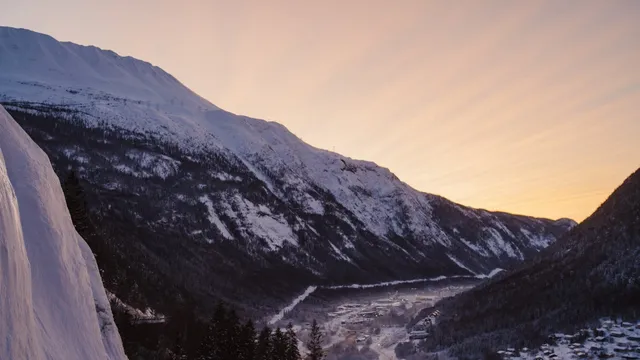
British climber dies after avalanche while climbing in Norway
2025-02-26 14:27- A British climber was killed in an avalanche while he and his friend attempted a climb in Norway.
- His friend sustained non-life-threatening injuries and was airlifted to a hospital.
- The event emphasizes the inherent risks of climbing in challenging weather conditions.
Express your sentiment!
Insights
In Norway, a tragic incident occurred involving two British climbers who were caught in an avalanche while attempting to scale The Gausta Marathon, a well-known frozen waterfall slope situated near Rjukan. The climbers set out on their expedition last Friday, unaware of the dangerous conditions that awaited them. The avalanche struck unexpectedly, engulfing them as they were traversing the snow and ice wall. The unfortunate event saw one climber perish, while his companion, a man in his 30s, sustained injuries that, fortunately, were not life-threatening. Mountain rescue crews faced considerable challenges during the operation to recover the body of the deceased climber. Bad weather hampered visibility, with rescue teams facing only 20-30 meters of sight. Additionally, poor mobile phone coverage in the area complicated communication efforts, making coordination of the rescue operation more difficult. It took until Tuesday for the body to be recovered due to these adverse conditions, thereby extending the rescue operation significantly. The injured climber was airlifted to Ullevål Hospital following an arduous descent made by rescue teams, which lasted several hours. The survivor was rescued on Saturday afternoon, with priorities placed on ensuring his safety. Local climbing guide Jørn Knustad highlighted that the region is not a popular climbing destination due to the time-consuming nature of scaling the waterfalls. The Gausta Marathon is characterized as the longest waterfall in the area, stretching at least 17 rope lengths, which adds to the complexity of any ascent. Knustad expressed that the climbers were likely experienced and adequately trained, as embarking on such a challenging trip would often require a significant level of skill and preparation. His insights suggest that the avalanche was an unpredictable act of nature rather than a failure of the climbers' expertise. The British Foreign, Commonwealth and Development Office has been in contact with local authorities and is providing assistance to the family of the deceased climber, as well as support to the injured survivor. This incident not only underscores the inherent risks associated with climbing in precarious conditions but also demonstrates the unpredictable nature of avalanches in mountainous terrain. Climbers need to be continuously aware of changing weather conditions and embrace safety protocols, as the consequences can be dire in situations like this.
Contexts
Avalanches are a significant hazard for climbers and winter sports enthusiasts, and understanding the safety measures associated with climbing in avalanche-prone areas is crucial. The risks associated with avalanches can be mitigated through proper planning, education, and equipment. Before embarking on a climbing expedition, climbers should assess current snow and weather conditions, as well as avalanche forecasts provided by local authorities. Utilizing resources such as the Avalanche Canada or respective country’s avalanche centers can provide detailed information on snowpack stability and the likelihood of avalanche activity. Familiarity with terrain features that can trigger avalanches, such as steep slopes, cornices, and specific snow conditions, plays a fundamental role in risk assessment and decision-making on the field. Proper training and education are essential components of avalanche safety. Climbers should seek to enroll in avalanche safety courses, where they can learn about snow science, terrain recognition, and rescue techniques. Understanding the different types of avalanches and the factors contributing to their occurrence—such as weather patterns, snow accumulation, and temperature changes—is vital. Additionally, practicing rescue skills, including proper use of avalanche transceivers, probes, and shovels, can significantly increase the odds of successfully locating and assisting a buried individual in case of an avalanche incident. The right equipment can make a substantial difference in the event of an avalanche. Essential gear includes an avalanche transceiver, a collapsible shovel, and an avalanche probe, all of which should be carried by every member of a climbing party. Awareness and training in the correct use of this equipment are imperative, as any delay in rescue can greatly reduce survival chances. Alongside avalanche-specific gear, climbers should opt for safety helmets and appropriate clothing to maintain body heat and protect against injuries. Furthermore, having a designated first aid kit is crucial for treating any physical injuries sustained during the climb or avalanche encounter. In addition to individual preparation, climbers should always prioritize group communication and responsibility. Establishing a clear plan before the climb, including specific roles and responsibilities, enables all members to act cohesively in case of an emergency. Maintaining a conservative approach by evaluating the group’s skill level against the climbing conditions is necessary to establish a safe environment. Regularly participating in group training and practicing rescue scenarios can enhance overall safety awareness. Ultimately, a combination of preparation, education, proper equipment, and sound judgment in decision-making can significantly enhance climbers' safety in avalanche-prone areas.